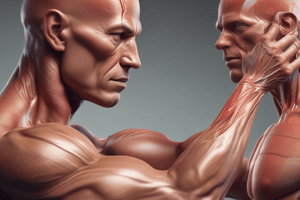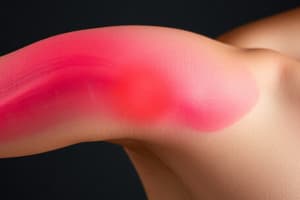Podcast
Questions and Answers
What is the first cellular response to muscle injury during the degeneration phase?
What is the first cellular response to muscle injury during the degeneration phase?
- Fibroblasts begin to form collagen
- T-lymphocytes migrate to the area
- Macrophages arrive at the injury site
- Neutrophils are the first on the scene (correct)
What process must occur for muscle regeneration to be successful following an injury?
What process must occur for muscle regeneration to be successful following an injury?
- Necrosis of the injured muscle fibers
- Complete fibrosis of the muscle tissue
- Absence of inflammatory mediators
- Intact basement membrane (correct)
Which of the following effects of cytokines during muscle repair involves the enhancement of vascular supply to new muscle cells?
Which of the following effects of cytokines during muscle repair involves the enhancement of vascular supply to new muscle cells?
- Proliferation
- Angiogenesis (correct)
- Differentiation
- Myofibrogenesis
During the inflammation phase of muscle injury repair, which cells are primarily responsible for phagocytosis of cellular debris?
During the inflammation phase of muscle injury repair, which cells are primarily responsible for phagocytosis of cellular debris?
What is a potential consequence of an intact basement membrane during muscle injury repair?
What is a potential consequence of an intact basement membrane during muscle injury repair?
What occurs to T-cells that recognize 'self' during their maturation?
What occurs to T-cells that recognize 'self' during their maturation?
Which of the following accurately describes the role of memory T-cells?
Which of the following accurately describes the role of memory T-cells?
In the formation of B-lymphocytes, which immunoglobulins are initially expressed by these cells after exiting the bone marrow?
In the formation of B-lymphocytes, which immunoglobulins are initially expressed by these cells after exiting the bone marrow?
What is a characteristic of primary immunodeficiency?
What is a characteristic of primary immunodeficiency?
Which of the following is NOT a source of iatrogenic immunodeficiency?
Which of the following is NOT a source of iatrogenic immunodeficiency?
What describes the key aspect of adaptive immunity in contrast to innate immunity?
What describes the key aspect of adaptive immunity in contrast to innate immunity?
Which of the following is a key component of innate immunity?
Which of the following is a key component of innate immunity?
What is the primary difference between an antigen and an immunogen?
What is the primary difference between an antigen and an immunogen?
What is the role of chemokines in innate immunity?
What is the role of chemokines in innate immunity?
What is the primary function of IgA in the immune system?
What is the primary function of IgA in the immune system?
Which statement about complement proteins in innate immunity is accurate?
Which statement about complement proteins in innate immunity is accurate?
Which statement correctly differentiates between active and passive immunity?
Which statement correctly differentiates between active and passive immunity?
What aspect of interferons contributes to their role in innate immunity?
What aspect of interferons contributes to their role in innate immunity?
How do innate and adaptive immunity interact primarily?
How do innate and adaptive immunity interact primarily?
Which immunoglobulin class is primarily involved in allergic reactions?
Which immunoglobulin class is primarily involved in allergic reactions?
What physiological change do acute phase proteins primarily promote?
What physiological change do acute phase proteins primarily promote?
What is the initial step in cell-mediated immunity?
What is the initial step in cell-mediated immunity?
What role does IgG play in the immune response?
What role does IgG play in the immune response?
Which immunity type involves the transplacental transfer of antibodies?
Which immunity type involves the transplacental transfer of antibodies?
What is the primary characteristic of the active immune response?
What is the primary characteristic of the active immune response?
Which immunoglobulin class serves as the antigen receptor on mature naïve B cells?
Which immunoglobulin class serves as the antigen receptor on mature naïve B cells?
What is the primary antibody produced during Type I hypersensitivity reactions?
What is the primary antibody produced during Type I hypersensitivity reactions?
Which of the following is a characteristic of Type II hypersensitivity reactions?
Which of the following is a characteristic of Type II hypersensitivity reactions?
What typically causes delayed reactions associated with Type IV hypersensitivity?
What typically causes delayed reactions associated with Type IV hypersensitivity?
Which condition is an example of an immune complex disease associated with Type III hypersensitivity?
Which condition is an example of an immune complex disease associated with Type III hypersensitivity?
Anaphylaxis, a severe reaction, is primarily associated with which type of hypersensitivity?
Anaphylaxis, a severe reaction, is primarily associated with which type of hypersensitivity?
Which of the following is NOT a feature of Type IV hypersensitivity?
Which of the following is NOT a feature of Type IV hypersensitivity?
In the context of Type II hypersensitivity, what does cross-reaction refer to?
In the context of Type II hypersensitivity, what does cross-reaction refer to?
Which example is commonly associated with Type I hypersensitivity?
Which example is commonly associated with Type I hypersensitivity?
What is the primary immunoglobulin produced in a Type I hypersensitivity reaction?
What is the primary immunoglobulin produced in a Type I hypersensitivity reaction?
In which type of hypersensitivity mechanism do antigen-antibody complexes play a significant role?
In which type of hypersensitivity mechanism do antigen-antibody complexes play a significant role?
Which type of hypersensitivity is characterized by a delayed response typically occurring 48-72 hours after exposure to an allergen?
Which type of hypersensitivity is characterized by a delayed response typically occurring 48-72 hours after exposure to an allergen?
What is a common clinical manifestation of Type I hypersensitivity?
What is a common clinical manifestation of Type I hypersensitivity?
Which of the following conditions illustrates the consequence of Type II hypersensitivity?
Which of the following conditions illustrates the consequence of Type II hypersensitivity?
What process is primarily associated with Type II hypersensitivity involving one's own tissues?
What process is primarily associated with Type II hypersensitivity involving one's own tissues?
What type of hypersensitivity may involve mechanisms leading to the rejection of transplanted organs?
What type of hypersensitivity may involve mechanisms leading to the rejection of transplanted organs?
Which example demonstrates hypersensitivity resulting from immune complex diseases?
Which example demonstrates hypersensitivity resulting from immune complex diseases?
Which immune response is mainly characterized by an inappropriate reaction to exogenous substances?
Which immune response is mainly characterized by an inappropriate reaction to exogenous substances?
Which of the following is not primarily involved in Type IV hypersensitivity?
Which of the following is not primarily involved in Type IV hypersensitivity?
Flashcards are hidden until you start studying
Study Notes
Skeletal Muscle Injury Repair
- Repair Process Following Muscle Strain or Contusion
- Hemostasis and Hematoma Formation: Initial response to injury involves stopping bleeding and forming a blood clot.
- Degeneration:
- Necrosis: Tissue death occurs, with neutrophils being the first responders.
- Chemotactic Agents: Released to attract inflammatory mediators to the injury site.
- Inflammation:
- Begins within 24-48 hours post-injury, crucial for healing.
- Involves phagocytosis of cellular debris by immune cells.
- Macrophages stimulate satellite cells to migrate, differentiate, and release various cytokines.
- T-lymphocytes increase in number as macrophages decline, continuing to release cytokines.
- Regeneration:
- Typically occurs 6-8 weeks after the injury, followed by remodeling of the new tissue.
- Fibrosis: Can develop, leading to less functional muscle tissue, but not always a consequence of injury.
Role of the Basement Membrane in Muscle Healing
- Integrity of Basement Membrane: Essential for regeneration; must remain intact.
- Satellite Cell Division: Crucial for maintaining the basement membrane's integrity.
- Satellite cells combine with other myogenic cells and fuse with remaining muscle fibers.
- Consequences of Damage: If compromised, fibrosis occurs, resulting in decreased functional capacity and increased risk of future injuries.
- Satellite Cell Division: Crucial for maintaining the basement membrane's integrity.
Effects of Cytokines on Satellite Cells / Muscle Cells During Repair
- Enhanced Resistance to Oxidative Stress: Promotes cell survival during the healing process.
- Block Myofibrogenesis: Prevents irregular muscle fiber formation, leading to improved healing outcomes.
- Proliferation: Stimulates cell division to increase the number of muscle cells.
- Differentiation: Encourages fusion of satellite cells with myofibers for regeneration.
- Angiogenesis: Supports the formation of new blood vessels, ensuring adequate vascular supply to the regenerated muscle tissue.
Immune System Overview
- Innate immunity is non-specific and responds rapidly to pathogens, initiating adaptive immunity.
- Adaptive immunity develops specificity and memory for pathogens, requiring days to weeks for activation.
Key Components of Innate Immunity
- Exterior Defenses: Epithelial barriers, mucosa, and secretions protect against pathogens.
- Cellular Components/Phagocytes: Include natural killer cells, neutrophils, monocytes/macrophages, eosinophils, basophils, mast cells, and platelets.
- Soluble Mediators:
- Complement: A protein system that induces inflammation and kills microbes.
- Cytokines: Proteins that modify cellular behavior in response to infection.
Types of Cytokines
- Chemokines: Small proteins that promote leukocyte migration and enhance inflammation.
- Interferons: Produced by virus-infected cells, increasing resistance to viral replication.
- Acute Phase Proteins: Pro-inflammatory cytokines that alter metabolism, blood flow, and protein production.
Components of Adaptive Immunity
- Humoral Immunity: Mediated by antibodies produced by B cells.
- Cell-Mediated Immunity: Involves T cells responding to infected cells.
Antigens vs. Immunogens
- Antigen: Any molecule that binds to an antibody or T-cell receptor.
- Immunogen: A specific antigen that elicits an immune response, often aided by adjuvants.
Active vs. Passive Immunity
- Active Immunity: Long-lasting immunity gained through exposure to antigens, either naturally (e.g., infection) or artificially (e.g., vaccines).
- Passive Immunity: Temporary immunity acquired by receiving antibodies from another individual; can be natural (e.g., maternal antibodies) or artificial (e.g., antibody injections).
Structure and Function of Antibodies
- Antibodies are produced by B lymphocytes, featuring:
- Fragment Antigen Binding Sites: Bind specific antigens with variable regions for specificity.
- Constant Regions: Determine the antibody's class and function.
Major Immunoglobulin (Ig) Classes
- IgM: First antibody produced in response, activates the complement system.
- IgG: Major antibody in blood, provides long-lasting immunity, crosses the placenta.
- IgA: Predominates in mucosal areas and secretions, protects mucosal surfaces.
- IgE: Associated with allergies and responses to parasites, found on mast cells and basophils.
- IgD: Functions as an antigen receptor on mature naïve B cells.
Clinical Relevance of Cell-Mediated Immunity
- Important for defense against intracellular pathogens and plays a role in transplant rejection and autoimmune diseases.
Process of Cell-Mediated Immunity
- Antigen-presenting cells (macrophages, dendritic cells) digest pathogens and present antigens to T cells in lymph nodes.
- T cells matching the antigen expand and differentiate, aiding in pathogen destruction and the activation of B cells.
Formation of T-Lymphocytes
- Origin in bone marrow, maturation occurs in the thymus where T-cell receptors are formed.
- Cells that recognize self-antigens are eliminated to prevent autoimmune diseases.
Formation and Maturation of B-Lymphocytes
- Matured B cells express IgM and IgD, and upon activation, divide and produce antibodies.
- Differentiate into plasma cells that secrete antibodies and memory B cells for future rapid response.
Phases of the Immune Response
- Recognition: Identifying pathogens.
- Amplification: Boosting immune signals.
- Effector: Eliminating pathogens.
- Termination: Shifting off immune response.
- Memory: Retaining information for future pathogen encounters.
Primary vs. Secondary Immunodeficiency
- Primary Immunodeficiency: Congenital defects disrupting T/B cells or lymphoid tissues.
- Secondary Immunodeficiency: Resulting from conditions or treatments that suppress immune function.
Sources of Iatrogenic Immunodeficiency
- Cytotoxic drugs, corticosteroids, immunosuppressive drugs, radiation therapy, and splenectomy can weaken immune responses.
Definition of Hypersensitivity
- Increased immune response to antigens, resulting in undesirable clinical effects.
- Four types of hypersensitivity reactions can occur concurrently or overlap.
Types of Hypersensitivity
Type I – Immediate Hypersensitivity (Atopy)
- Elevated production of IgE instead of IgG.
- Primarily involves mast cell degranulation and histamine release.
- Triggered by allergens, commonly harmless substances such as:
- Shellfish
- Pet dander
- Dust mites
- Peanuts
- Latex
- Insect venom
- Anaphylaxis represents a systemic Type I hypersensitivity response.
Type II – Cytotoxic Reactions to Self-Antigens
- Immune response targets the body's own tissues.
- Mechanisms include complement activation, agglutination, and phagocytosis.
- Notable examples:
- Hemolytic disease of the newborn.
- Myasthenia gravis.
- Cross-reactivity occurs between foreign antigens and body tissues, exemplified by:
- Hemolytic streptococci linked to mitral valve disease.
- Guillain-Barre syndrome.
Type III – Immune Complex Diseases
- Characterized by antibody-antigen complexes depositing in small blood vessels.
- This leads to complement cascade activation, acute inflammation, and tissue damage.
- Examples of diseases include:
- Rheumatoid arthritis.
- Nephritis.
- Pericarditis.
- Vasculitis, as seen in systemic lupus erythematosus (where cell nucleus acts as the antigen).
Type IV – Cell-Mediated Immunity
- Exhibits a delayed hypersensitivity reaction, typically 48-72 hours post-exposure.
- Based on interactions between macrophages and T-cells, which require time to develop.
- Common examples include:
- Transplant rejection.
- Delayed contact dermatitis, such as reactions to poison ivy.
Definition of Hypersensitivity
- Increased immune response to antigens, resulting in undesirable clinical effects.
- Four types of hypersensitivity reactions can occur concurrently or overlap.
Types of Hypersensitivity
Type I – Immediate Hypersensitivity (Atopy)
- Elevated production of IgE instead of IgG.
- Primarily involves mast cell degranulation and histamine release.
- Triggered by allergens, commonly harmless substances such as:
- Shellfish
- Pet dander
- Dust mites
- Peanuts
- Latex
- Insect venom
- Anaphylaxis represents a systemic Type I hypersensitivity response.
Type II – Cytotoxic Reactions to Self-Antigens
- Immune response targets the body's own tissues.
- Mechanisms include complement activation, agglutination, and phagocytosis.
- Notable examples:
- Hemolytic disease of the newborn.
- Myasthenia gravis.
- Cross-reactivity occurs between foreign antigens and body tissues, exemplified by:
- Hemolytic streptococci linked to mitral valve disease.
- Guillain-Barre syndrome.
Type III – Immune Complex Diseases
- Characterized by antibody-antigen complexes depositing in small blood vessels.
- This leads to complement cascade activation, acute inflammation, and tissue damage.
- Examples of diseases include:
- Rheumatoid arthritis.
- Nephritis.
- Pericarditis.
- Vasculitis, as seen in systemic lupus erythematosus (where cell nucleus acts as the antigen).
Type IV – Cell-Mediated Immunity
- Exhibits a delayed hypersensitivity reaction, typically 48-72 hours post-exposure.
- Based on interactions between macrophages and T-cells, which require time to develop.
- Common examples include:
- Transplant rejection.
- Delayed contact dermatitis, such as reactions to poison ivy.
Studying That Suits You
Use AI to generate personalized quizzes and flashcards to suit your learning preferences.




